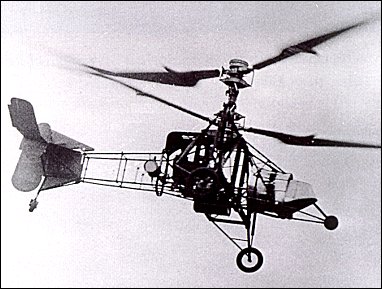
| Breguet-Dorand "Gyroplane Laboratoire" project |  |
 |

| Breguet-Dorand "Gyroplane Laboratoire" project |  |
 |
|
An even more significant effort then under way in France was the Breguet Gyroplane, a coaxial helicopter with counterrotating rotors. Returning to his lifelong fascination with helicopters, an older Louis Breguet oversaw but did not participate directly in the construction and testing of this compact single-seater. The Gyroplane was badly damaged in a ground accident at the end of 1933. Rebuilt with extensive modifications and tested conservatively on the ground, it resumed flight tests in June 1935. Breguet then audaciously committed it to maneuvering, speed, altitude, and endurance requirements far in excess of anything so far accomplished by a helicopter. The Breguet Gyroplane flew at 120km/h, climbed to an altitude of 158m, and remained in the air for more than one hour during tests that concluded late in 1936. Arguably the world's first successful helicopter, this historic machine was badly damaged in June 1939 during autorotation tests. It was subsequently destroyed by Allied bombing of historic Villacoublay Airfield in 1943. J.P.Spencer "Whirlybirds: A History of the U.S. Helicopter Pioneers", 1998
After the destruction of the Breguet-Richet No.2bis helicopter in 1909, Louis Breguet suspended his experiments into the problems connected with rotary-winged flight in order to concentrate on the development of fixed-wing aircraft. However, towards the end of the 1920s he returned to the study of helicopters and in 1929-30 took out patents for systems for stabilising aircraft of this type while in flight. In 1931 he formed the Syndicat d'Etudes du Gyroplane, with Rene Dorand (who had joined the Breguet company in 1924) as technical director, and began the design and construction of an experimental machine known as the Gyroplane Laboratoire. Intended originally to be powered by a 240hp Breguet-Bugatti engine, it consisted basically of a steel-tube open framework supporting the engine, fuel tank, flight controls and pilot, with rear booms carrying the plywood-covered tail surfaces. An unusually wide track main undercarriage was mounted on outriggers from the central framework, with a small tailwheel and a nosewheel to prevent the machine tipping forward on landing. The transmission from the big radial engine drove a pair of co-axial, counter-rotating, 2-blade metal rotors whose blades had an aerofoil section and an unusually large diameter. One rotor shaft turned inside the other, each rotor thus cancelling out the torque created by the other. Novel features for the time were the use of a cyclic pitch control for lateral and longitudinal movement, and collective pitch for movement in the vertical plane. The achievements of the Breguet-Dorand aeroplane, eclipsed by the more widely publicised efforts of its near contemporary, the Focke-Achgelis Fw 61, have been accorded less prominence than they deserve. The later Fw 61 was demonstrably the superior machine of the two, but the advance in helicopter technology brought by the French design is most apparent when compared with the best that had gone before it. It is believed that the Breguet-Dorand aircraft was completed by November 1933: it was then little more than three years since the small Italian d'Ascanio machine had set up FAI distance, height and endurance records of 1.078km, 18m, and 8 min. 45.2 sec. respectively. Within a year and a half of its first flight on 26 June 1935 the Breguet-Dorand machine, piloted by Maurice Claisse, had eclipsed these with the following performances: 14 December 1935, distance in a closed circuit of 500m; 26 September 1936, height of 158m; 24 November 1936, endurance of 1 hr. 2 min. 5 sec; distance in a closed circuit of 44km; and speed over a straight course of 44.692km/h. Apart from advancing helicopter performance in these spheres, the Breguet-Dorand also, after a little early evidence of instability, exhibited good characteristics of controllability, and in 1937 (after a similar achievement by the Fw 61 in Germany) it made its first 'engine off' landing using autorotation. It is not certain whether the Bugatti engine was ever installed; the aircraft did most or all of its flying with the more powerful Hispano engine. It continued to carry out useful experimental work up to the outbreak of World War 2, but was destroyed in 1943 during an Allied air attack on the airfield at Villa-coublay where it was housed. K.Munson "Helicopters And Other Rotorcraft Since 1907", 1968
|